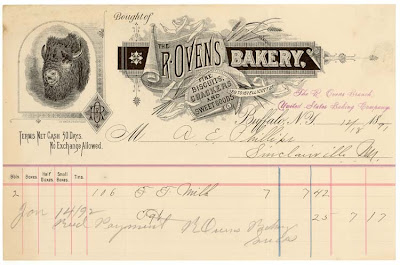Another interesting collecting area is that of billheads for cracker and/or biscuit companies. First, a little history. Crackers are an American invention. In 1792, John Pearson of Newbury, Massachusetts made a cracker-like bread product that he called "pilot bread". It became a hit with sailors because of its shelf-life - some of you know it by its other names hardtack or sea biscuit. In 1801, another Massachusetts baker, Josiah Bent, burnt some biscuits in his oven and the crackling noise that emanated from the oven gave way to the term "cracker". By 1840, three cracker varieties were on the market - butter crackers, soda crackers and sugar biscuits. Because crackers were less perishable than bread and thus more widely distributed. Since crackers were unleavened production was simpler and easily mechanized. In 1845, the Kennedy bakery in Arlington Massachusetts introduced steam power to run its machinery and fleets of wagons were soon leaving the factory. Crackers also became an important food for armies during the Civil War due to them being nonperishable. In 1890, the National Biscuit Company (today now known as Nabisco), developed the automatic wrapping machine. Biscuit and cracker companies expanded into wholesale distribution of their products over a wide area in the 1870s and 1880s. Jobbers were used to take advantage of rail transportation and to operate in the national market. Competition drove companies to merger and consolidation in the 1880s. In 1898, the National Biscuit Company was formed through the efforts of the Moore Brothers.









Comments